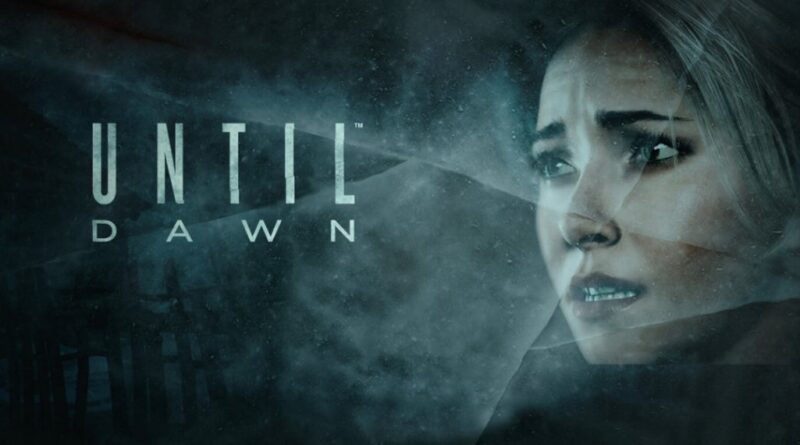“Until Dawn”: A Fun Adaptation Of A Video Game, That Won’t Keep You Up All Night | Review
I’m not the primary target audience for horror games. Until now, I haven’t found the time, even though I would have loved the experience, and maybe even managed to be more scared in it than in the average horror movie. So when movies come out that are based to some extent on a game, I’m in trouble. It’s hard for me to appreciate how the movie transfers the experience from the computer or video games to the big screen, or to understand the little references that fans like to find, or to complain about changes compared to the original version. Under these conditions, I still have to try to judge the work by the standards of a movie, and sometimes I miss part of the experience, as in the case of “Five Nights at Freddy’s”, about which my opinions were divided.
“Until Dawn” is based on a survival horror game from 2015. As part of my preparation, I spent minutes watching a complete game walkthrough video, Which was not the “real deal”, but gave me some appreciation. So I already understood that “Until Dawn” is the closest thing to a horror movie on the PlayStation, with protagonists who look like characters from a film, rich dialogues, and a full-fledged investigation that takes place in an isolated house, where the goal is – as you can deduce from the name – to survive until dawn. The film takes the general idea, changes the narrative and its horror structure a bit, and the result is fun, but not immersive or engaging enough.
What Is The Movie “Until Dawn” About?
What stands out in the film adaptation, and also drew quite a lot of criticism from fans of the game, is that the connection to the game is quite tenuous. Some even claimed that it was a standalone film, with the link to the game being mainly for promotional purposes. There is a different framework story here, except perhaps for the central principle, in which the characters try to survive time and time again, with each death by another horror cliché causing the clock to reset and a new “game” to start. If the original game’s prominent principle was “The Butterfly Effect,” where players face choices that affect the plot, resulting in dozens of scenarios and possible endings, the film’s principle is a time loop. The film falls between the chairs, as fans of the game may be disappointed (and many of them were). Neutral viewers may see the film without all the associated meaning of a film based on a game, and probably without much desire to play it either.
At the center of the film’s plot is Clover (Ella Rubin, a small role in “Anora” and a larger role in “Fear Street: Prom Queen”), who lost her sister Melanie about a year ago: literally, because the sister (Maia Mitchell, “Teen Beach”, “The Fosters”) disappeared. Clover goes out with some friends to look for clues, with the relatives being more or less familiar representations from horror films. There you will find the ex Max (Michael Cimino, “Annabelle Comes Home” and the TV series “Love, Victor” and “Motorheads”), who still fantasizes about a comeback; the Asian-American friend Megan (Ji-young Yoo, “Moxy,” “Freaky Tales”) who for some reason has some mystical abilities; the disturbed and slightly promiscuous friend Nina (Odessa A’zion from the remake of “Hellraiser” and TV series “Fam” and “Grand Army”); and Abel (Belmont Cameli from the remake of “Saved by the Bell”), Nina’s current boyfriend who is still a bit of a outsider to the group.

Our guys arrive at the gas station, from where the sister sent the last message, and realize that there is a mining town called “Glore Valley” where young people come and disappear. On the way, they encounter a mysterious storm and arrive at a visitor center, where there is a room with pictures of people who have disappeared – including Melanie, of course – and an hourglass. Very soon, someone will murder the unfortunate young people.
Fortunately (or not), they will wake up and relive that day, until the moment they are murdered again, in a different way. They quickly realize that they have to somehow survive until dawn, or as the film puts it: “survive the night, or become part of it.” The reason is that there is a limited number of attempts, because each time the characters become more fragile. Unfortunately, death causes slight damage to physical or mental resilience, even if they wake up again.
Here is the official trailer of “Until Dawn”:
We’ve Been In This Loop Before, But Not In The Game
Several elements appear in the game and are also reflected in the film, such as the basic idea of someone close to them who has disappeared (in the game, these were twin sisters, following a prank gone wrong), and especially the need to survive in a cabin full of horrors. Some of the creatures also return from the game. Even an actor who plays a specific character in the game (Peter Stormare, who contributed his voice and movement to the original game, and this time appears in the real version as one of the characters who explains what exactly is happening in this town), but that’s probably about it.
“Until Dawn” takes a turn towards a time loop, similar to many other films, which somewhat contradicts the game’s narrative, but it works to some extent. I love movies based on time loops, whether in our favorite genre (for example, “Happy Death Day” movie) or in other genres such as comedy (“Groundhog Day”, “Palm Springs”), action (“Edge of Tomorrow”, “Source Code”), and so on.

In movies with time loops, we often see the same plot unfold, with characters trying to change the outcome. However, in “Until Dawn,” the dangers the characters face are entirely different. Here we see the best horror repertoire, at the level of the genre or even the specific threat. We can argue that each “loop” is a kind of short horror story, in which we encounter almost the entire catalog of horror: a masked killer, a witch, an exorcism, a scary clown doll, a giant monster, exploding bodies, bodies gradually disintegrating, Found Footage, and so on. The film presents an explanation: the assumption that each time the fears the characters face change and become more extreme, because otherwise it would be boring and ineffective. This explanation is quite logical in the plot of the film (as far as such a plot can seem “logical”), but in my opinion, it somewhat harms the experience of the viewers.
“Until Dawn” can be seen as a collection of scenes and sequences, which seem to have come from other films, or as the poster says: “Every night a different nightmare.” There are a lot of scares, jump scares, and kills here, in some cases done in a successful way (mostly frightening). The problem is that these scenes fail to form a cohesive whole, as the film becomes repetitive at some point. Many recurring deaths do not include any added value, also because there is no progress or connection between them, except for the fact that they allow our heroes to die time and time again. In the game “Until Dawn” and some of the time loop films mentioned earlier, the idea is that every decision may affect death or the chance of living. Here, death essentially “resets” everything, and there is no real impact on the way it occurred for the next round. The cyclical nightmare allows us to watch many subgenres of horror in one film, but there is a limit to how much their identification can hold a movie.

Missing: A Mystery and Interesting Characters
The mystery at the center of “Until Dawn” exists, but it is far from exciting. The young people generally discover the story of this place. Still, the mystery is quite fundamental and far from interesting, even to the level of a MacGuffin – that is, a plot device that is responsible for advancing the plot and motivating the heroes. Still, in a broad sense it is worthless or meaningless for the viewer. I was not too interested in the fate of this mining town or even the missing sister, who appears here as a flashback or in her renewed version, as something a little less human.
In this context, we must stop and say a big thank you to the makeup and effects department, who managed, for example, to turn the sexy Maia Mitchell into a bloody monster. In general, relying mainly on practical effects and less on visual effects did the film a favor. The change that the characters undergo after each death, along with the vague signs of the trauma they experienced, effectively conveys the point. There’s a certain sense of a race against time, unlike some of the time-loop films that correspond to the fact that death is infinite, so there’s no problem with dying on purpose in entertaining ways (for example, jumping out of a plane without a parachute).
On the surface, the film has all the potential to be truly disturbing and fun, but in practice, it only partially works. Don’t expect a brilliant script here, full of references like the excellent “Cabin in the Woods” or “The Final Girls,” although there are elements here that can remind you of those films. “Until Dawn” presents some creative and blood-filled scenes, but falls short in terms of their intensity. It also misses the mark in its references to other cinematic works, which contain mainly dry, reflexive references, lacking brilliance or an attempt to bring an interesting twist to these representations.
Another thing that is missing here is delicious humor. In other words, although the film was enjoyable primarily, it is standard in many aspects. I find it hard to believe that, unlike some films I mentioned, it would become a cult film. It includes references to films, mainly by the characters who are aware of the cinematic world, but without the brilliant humor and irony that one would hope for from a hilarious movie.

How Was The Cast Of Until Dawn?
The actors, led by the talented Ella Rubin, do a good job. The problem is that the script makes it difficult for them. Some of the characters are superficial or even annoying, and primarily don’t contribute much. They are here mainly to die time and time again, and not to develop or be emotionally engaging as the film progresses.
The primary concern here is how they will die this time, or a little more reflexively: in what subgenre or style will the creators choose to kill the characters, because it is clear that they will die (at least until the last scenes). The problem is that even in the different styles, the attempt to create horror is based mainly on jump scares. The result is that after a few rounds of killing, the film becomes a bit predictable and loses its effectiveness. If you are trying to involve styles or subgenres of horror, it would be appropriate, in my opinion, to try to “explore” other types of scares as well.
Until Dawn’s Cinematic Work: Mostly Appealing
The script is mostly effective, but a bit disappointing when you consider the respectable names behind it: Gary Dauberman (who wrote the screenplay for the three “Annabelle” films and was one of the writers of the two blockbuster “It” films) and Blair Butler (who wrote the lovable “The Invitation” from 2015 and co-wrote the screenplays of the enjoyable “Polaroid” and “Hell Fest”) have already shown that they can write fun films with added value, and this is a little less the case here.
The director, David F. Sandberg, is another name that may not mean much to you, but you’ve probably already seen a few of his films. He created “Lights Out,” initially as a brilliant short film, which in 2016 became a likable but slightly less effective horror film, starring Teresa Palmer. P. Sandberg then directed the excellent “Annabelle: Creation,” where he showed an ability to create creepy characters and some well-paced scenes. In between came two “Shazam” films, superhero (or anti-hero) films that showcased his ability to craft great action with humor, even if it’s hard to argue that they were too immersive. Contrary to his criticism of the “Shazam” films, for example, the commercial aspect or the reliance on computer effects, here he seems to have had a free hand.

In “Until Dawn,” you can see that the freehand behind the camera is skilled, because the film is well-made, mainly technically. But, again, it’s lacking something that would make the movie stand out, be scarier or more enjoyable, and certainly also be memorable over time. P. Sandberg has shown so far that he knows how to create interesting scenes and short stories, but the final connection of everything to complete films is a bit lacking, and this is especially noticeable in “Until Dawn”.
What I found missing here may be a closer connection between the creators and the world in which the film takes place, or, in this case, to the game itself. Some would say the movie is some original story set in the “universe” of the computer game, with some similar ideas and many more differences, rather than a direct adaptation. The director addressed this: “The game is pretty much a 10-hour movie, so I think it wouldn’t have been as interesting for me if we were doing just the game, because then it’s going to be like a cut-down, non-interactive version of the game, which just wouldn’t be the same thing.” In other interviews, it seems that what attracted him more was the possibility of being a “kid in a candy store,” with the possibility of exploring the genre from different angles.
So why exactly base the film on the game “Until Dawn,” beyond trying to attract viewers? It’s unclear whether there’s a certain distance here that affected the result, or whether the focus on the game is primarily for promotional purposes (the film was released exactly ten years after the game was released for the PlayStation, and received much of the hype due to being based on the game), or whether the truth lies somewhere in between. The truth is that many other names could have been suitable for the film, but apparently “Cabin in the Woods” was already taken.
Reviews of “Until Dawn” were quite mixed, and its box office success was reasonable but not hysterical (about $53 million, against a budget of about $15 million). It’s hard to argue that it’s a terrible film, but on the other hand, it’s also too successful, or something that you will remember for a long time. It’s possible that in a world where I have time to play more horror games, including “Until Dawn,” I’ll revisit the film, and my impressions will be different, whether for the better or the worse. Ugh, why is it so hard for me to fit horror games into my schedule?
Until Dawn (2025) – Frequently Asked Questions
Who made Until Down? The director of the film is Swedish David P. Sandberg, who previously directed “Lights Out” (2016), “Annabelle: Creation” (2017), “Shazam!” (2019), and “Shazam! Fury of the Gods” (2023).
Who plays in Until Dawn? Millions of video game lovers worldwide are drawn to it because it is very popular. Oh, did you want to ask about the cast of the film? Well, the cast of Until Down includes Ella Rubin, Michael Cimino, Odessa A’zion, Ji-young Yoo, Belmont Cameli, and Peter Stormare, who reprises his role from the game.
Who wrote Until Down? Gary Dauberman and Blair Butler are responsible for the script of the movie. They based it on the plot of the game, albeit loosely, as it is more of a standalone film set in the game’s universe.
How long is Until Dawn? The runtime of the film is about 103 minutes, which is shorter than the “10 hours horror film”, as the director described the video game it is based on.
Where was the movie made? The film was produced in the United States, while principal photography took place in Budapest, Hungary, between August and October 2024.
What languages are spoken in the film? English, but it has many Horror Sounds from different sub-genres.
When did Until Dawn come out? The official release date of the movie was April 25, 2025.
What was the budget of Until Dawn? The estimated budget of the film is about $15 million.
What are the gross earnings of Until Dawn? The movie grossed about $53 million worldwide, according to Box Office Mojo.
What do the reviews say about Until Dawn? The film currently holds a 5.8 rating on IMDB. On Rotten Tomatoes, it has a 52% Tomatometer, meaning more than half of the professional critics gave it a positive review.
💀 Killer Deals & Scary Recommendations 💀
🎭 Costumes & Accessories
HalloweenCostumes Fun Costumes Entertainment Earth
🛒 Online Shopping
AliExpress Amazon Walmart Etsy
🧛 Collectibles & Horror Brands
Funko Hot Topic Lego Spirit Halloween
🎢 Attractions & Tours
GetYourGuide Tiqets Viator Klook
📖 Blogs & Horror Sites
Bloody Disgusting iHorror Fangoria
🩸 Disclaimer: Some links are affiliate links. The price stays the same – it just helps keep the site alive 👻






